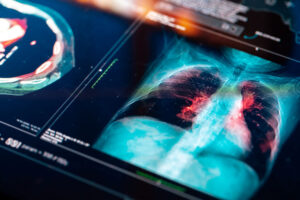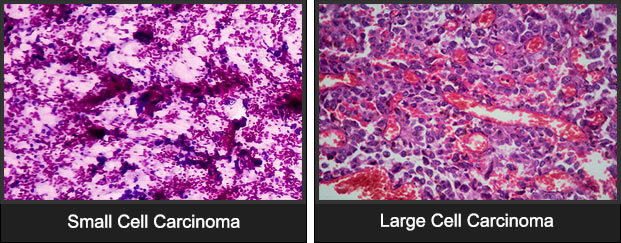Large Cell Carcinoma
Pulmonary large cell carcinoma is an aggressive type of non-small cell lung cancer. Large cell carcinoma can be caused by smoking, asbestos exposure, and other factors. Medical treatment can help you live longer after a large cell carcinoma diagnosis. Get help for large cell carcinoma from our team right now.
What Is Large Cell Carcinoma?
Large cell carcinoma is one of the types of non-small cell lung cancer (NSCLC). This type of cancer is very rare, accounting for approximately 7% of all lung cancers. It’s also called large cell lung cancer, according to the LUNGevity Foundation.
 Large cell carcinoma tumors have a white or tan color, and tend to grow in clusters or sheets throughout the body.
Large cell carcinoma tumors have a white or tan color, and tend to grow in clusters or sheets throughout the body.
Doctors typically diagnose a patient with large cell carcinoma if their cancer cells are not readily classified into one of the other types of NSCLC (those being squamous cell lung cancer or adenocarcinomas).
In fact, as diagnostic technology advances, many cases of large cell carcinoma are now being classified as one of the other two types.
Like all forms of lung cancer, large cell carcinoma can be caused by exposure to harmful substances like cigarette smoke and asbestos exposure. Fortunately, those with large cell carcinoma can pursue medical treatment — and some may qualify for financial aid. Learn more by getting a free case review.
- Access Financial Aid and Justice
- Learn About Your Options
- Contact Us for Free

What Causes Large Cell Carcinoma Tumors?
Like other lung cancers, large cell carcinoma tumors can develop if carcinogens (cancer-causing agents) damage the cells lining the lungs.
- Asbestos: Inhaling or swallowing asbestos fibers can cause large cell carcinoma or other types of lung cancer. People who worked with or around asbestos in shipyards, construction lots, or on other job sites are more likely to develop large cell carcinomas and other forms of lung cancer.
- Smoking cigarettes: Cigarettes remain the biggest underlying cause of all types of NSCLC.
- Radon: This is a radioactive, tasteless, odorless, and invisible gas that is usually concentrated in houses and basements.
- Other carcinogens in the workplace: Arsenic, air pollution, uranium, nickel compounds, mustard gas, and diesel exhaust can all lead to large cell carcinoma or other types of NSCLC.
- Secondhand smoke: This is the inhalation of tobacco smoke by individuals other than the smoker. Exposure to secondhand smoke increases the risk of large cell carcinoma and lung cancer.
Some of the causes have a synergistic effect, meaning the risks are multiplied. For example, smokers who were exposed to asbestos regularly have a higher chance of developing lung cancers than those who just smoked or only suffered from asbestos exposure.
Symptoms of Large Cell Carcinoma
People with large cell lung carcinoma may not experience symptoms, especially in the early stages of this cancer.
Common symptoms of large cell carcinoma include:
- Appetite loss
- Bone pain
- Coughing up rust-colored mucus or blood
- Chest pain
- Fatigue
- Voice hoarseness
The symptoms of large cell carcinoma are not significantly different from the other types of NSCLC.
Diagnosing Large Cell Carcinoma
There are several ways to diagnose large cell carcinoma. Which tests may be right for you will be determined by your doctor and health care team.
Diagnostic tests for large cell carcinoma include:
- Bronchoscopy, which is a procedure that lets doctors look at your air passages and lungs. During bronchoscopy, your health care provider passes a thin tube through your mouth or nose and into your lungs.
- Chest X-rays, which can show doctors whether you have tumors or suspicious growths in your lungs.
- Computed tomography (CT) scans, which combine a series of X-ray images taken from different angles. This way, the CT scans create cross-section slices of the interior of your body.
- Magnetic resonance imaging (MRI) scans, which use computer-generated radio waves and a magnetic field to create images of tissues and organs in your body.


A biopsy is a tissue or fluid sample taken from your body. Pathologists examine the sample to determine whether it has large cell carcinoma cells. They may also perform a cytology, which is a biopsy performed with smaller pieces of tissue.
Diagnosed with large cell carcinoma after asbestos exposure? See if you qualify for financial compensation. Call (877) 446-5767 now.
Large Cell Carcinoma Misdiagnosis
Sometimes, large cell carcinoma can be misdiagnosed despite the best efforts of doctors.
Large cell carcinoma may be misdiagnosed as:
- Asthma
- Acid reflux
- Chronic obstructive pulmonary disease (COPD)
- Gastroesophageal reflux disease (GERD)
- Inflammatory myofibroblastic tumors
- Lymphoma
- Lung nodules
- Tuberculosis
- Pulmonary embolism
A misdiagnosis can prevent you from receiving proper treatment on time. If you believe your large cell carcinoma has been misdiagnosed, get a second opinion from a cancer expert.
Types of Large Cell Carcinoma
As a diagnosis is being confirmed, doctors may classify your large cell carcinoma into one of several subtypes.
Types of large cell carcinoma include:
- Basaloid carcinoma: This type is usually located in the center of the lung or bronchus (one of the major airways connecting the lung and windpipe).
- Clear cell carcinoma: This is a very rare subtype. It develops when glycogen, a type of sugar stored in the body, builds up over time.
- Large cell neuroendocrine carcinoma (LCNEC): These tumors usually develop in the lung or gastrointestinal tract and are very aggressive.
- Combined LCNEC: This is an extremely rare tumor which has features of other types of lung cancer, including squamous cell carcinoma, lung adenocarcinoma, and giant cell carcinoma.
- Lymphoepithelioma-like carcinoma: This is extremely rare, with only 200 known cases. It’s linked to the Epstein-Barr virs, which commonly causes mononucleosis (mono).
- Rhaboid large cell carcinoma: This is a rather aggresive subtype that can be found in both children and adults.
Large Cell Carcinoma vs. Small Cell Carcinoma


Large cell carcinoma should not be confused with small cell lung carcinoma, also known as small cell lung cancer (SCLC).
SCLC is a rare, fast-growing lung cancer that usually affects people with an extended history of smoking tobacco.
The cells of this cancer look flat, much like oats, and are also much tinier when viewed under a microscope compared to those of large cell carcinoma.
Prognosis for Large Cell Carcinoma
The prognosis, or likely outcome, of large cell carcinoma of the lung varies depending on the size, subtype, and staging of the tumors. However, the prognosis is generally poor.
Doctors typically measure the prognosis for large cell carcinoma using survival rate and life expectancy.
The general five-year survival rate for large cell carcinoma patients is 19%, according to a 2020 study from the journal Translational Lung Cancer Research. The overall life expectancy for large cell carcinoma was 35 months in the same study.
However, the prognosis for large cell carcinomas can vary by subtype. For instance, LCNEC patients only have a median life expectancy of approximately 6 months after diagnosis.
A great way to improve your large cell carcinoma prognosis is to get treated. Afford lung cancer treatments now: Get a free case review to learn more.
- Access Financial Aid and Justice
- Learn About Your Options
- Contact Us for Free



Treatment Options for Large Cell Carcinoma Patients
There are several lung cancer treatments for large cell carcinoma patients, such as surgery, chemotherapy, and clinical trials.
Which treatment is the best choice for you or a loved one depends on various factors. These factors include the stage of the cancer, your age, medical history, and whether cancer metastasis (spread to the lymph nodes and other parts of the body) has occurred.
Surgery
Surgery may be an option if the large cell carcinoma was detected early and has not spread. Depending on how extensive your cancer is, doctors may remove all or part of your lung in a process known as lung resection.
Chemotherapy
Chemotherapy uses drugs that kill fast-growing cells like large cell carcinoma lung tumors. Chemotherapy drugs have multiple negative side effects, such as hair loss, weight loss, anemia, tiredness, and infections. However, chemotherapy is often an effective way to fight this cancer.
Radiation Therapy
Your health care provider may use radiation therapy if the large cell carcinoma has grown too large to remove through surgery. Radiation slows cell growth by damaging their DNA. Eventually, the cancer cells stop dividing and die, causing the tumor to shrink.
Targeted Cell Therapy
Targeted therapy attacks the mutations in lung cancer cells that help them grow, divide, and spread. Unlike radiation and chemotherapy, targeted cell therapy can spare more healthy cells.
Immunotherapy
Immunotherapy drugs stimulate your immune system to fight cancer. There are many types of immunotherapy that could be used to treat large cell carcinoma, including cancer vaccines, tumor-infecting viruses, and checkpoint inhibitors.
Find Help for Someone Facing Large Cell Carcinoma
Receiving a large cell carcinoma diagnosis can be traumatic, especially if you don’t know what the future holds. Treatments can also be costly without insurance.
Fortunately, if you have large cell carcinoma, Lung Cancer Group can help you pursue financial compensation for your medical bills, pain, and suffering.
Get a free case review now to find out your eligibility.
Large Cell Carcinoma FAQs
Who is at risk of large cell carcinoma?
People at risk of large cell carcinoma and other types of lung cancer include those who smoked and those who were exposed to asbestos, radon, and other toxins.
Smoking cigarettes remains the biggest overall cause of all types of lung cancer.
Is large cell carcinoma curable?
Large cell carcinoma generally has a poor outlook. However, it may be curable if your providers catch and treat it in the early stages.
Is large cell carcinoma rare?
Yes, large cell carcinoma is rare. It only accounts for 7% of all lung cancer cases.
Can large cell carcinoma go into remission?
Yes, large cell carcinoma can go into remission, especially if the provider diagnoses and treats the condition in its early stages.
What is the survival time of large cell carcinoma without treatment?
The survival time for non-small cell lung cancers (NSCLC) like large cell carcinoma is 35 months. For NSCLC patients who don’t receive treatment, the average survival time is just slightly over 7 months.

